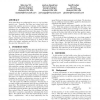Free Online Productivity Tools
i2Speak
i2Symbol
i2OCR
iTex2Img
iWeb2Print
iWeb2Shot
i2Type
iPdf2Split
iPdf2Merge
i2Bopomofo
i2Arabic
i2Style
i2Image
i2PDF
iLatex2Rtf
Sci2ools
CEAS
2006
Springer
2006
Springer
Learning at Low False Positive Rates
Most spam filters are configured for use at a very low falsepositive rate. Typically, the filters are trained with techniques that optimize accuracy or entropy, rather than performance in this configuration. We describe two different techniques for optimizing for the low false-positive region. One method weights good data more than spam. The other method uses a two-stage technique of first finding data in the low false-positive region, and then learning using this subset. We show that with two different learning algorithms, logistic regression and Naive Bayes, we achieve substantial improvements, reducing missed spam by as much as 20% relative for logistic regression and 40% for Naive Bayes at the same low false-positive rate.
CEAS 2006 | Internet Technology | Low False-positive Region | Low Falsepositive Rate | Most Spam Filters |
| Added | 20 Aug 2010 |
| Updated | 20 Aug 2010 |
| Type | Conference |
| Year | 2006 |
| Where | CEAS |
| Authors | Wen-tau Yih, Joshua Goodman, Geoff Hulten |
Comments (0)

